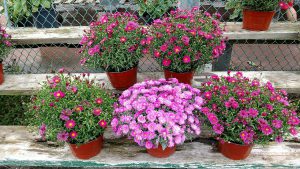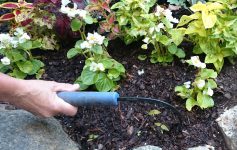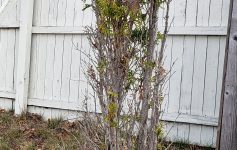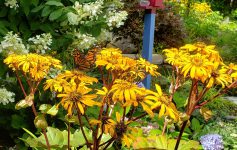 Mums seem to dominate most fall garden landscapes. They have become the “go-to” fall garden choice. I however, like to use Asters in my fall displays. Sadly the Aster is often overlooked by gardeners when planning out their late season gardens. So you will not find an abundant number of varieties at your garden centers. I did however find a nice selection at Hewitts in Saratoga Springs for my Fall displays this year..
Mums seem to dominate most fall garden landscapes. They have become the “go-to” fall garden choice. I however, like to use Asters in my fall displays. Sadly the Aster is often overlooked by gardeners when planning out their late season gardens. So you will not find an abundant number of varieties at your garden centers. I did however find a nice selection at Hewitts in Saratoga Springs for my Fall displays this year..
Asters are a strong performer in our North Country growing region. When your summer blossoms begin to fade and turn brown, these are a welcome splash of color to compliment the other reliable fall bloomers such as Sedum varieties and Montaux Daisies. The Aster boasts a tiny daisy-like flower in shades of pink and purple. And the Aster attracts late season butterflies and other pollinator visitors. I am still enjoying Monarch butterflies this week in my gardens, compliments of my Asters!
The Aster’s growing preferences are a perfect match for our region. They prefer climates with cooler, moist summers and cool night temperatures. Pick a full sun to part shade location in your garden. As always, the soil should be well-draining, moist (they respond well to automated sprinkler properties) and good rich amended soil. I always add my favorite 3-3-3 fertilizer with mychorrhizal fungi to the planting hole. This gives them a great root boast. Keep a good layer of mulch around the plant to keep the roots cooler and moist. Make sure to add mulch each spring.
Asters are a low maintenance perennial when the site is properly selected. The lower stems will brown if they do not receive proper moisture. They have the typical problems with powdery mildew, leaf spot and aphids. But that is easily taken care of with applications of Neem Oil. Some of the newer low growing varieties such a Woods Purple, Woods Pink or Woods Blue are mildew resistant. Aster varieties range from 8 inches to 8 feet! That gives a gardener a great deal of flexibility in designs. I prefer the variety with a growth habit of approximately 15 inches. It offers a nice dome-like appearance that compliments the Autumn Joy sedum and perennial Mums. The native New York Aster, one of the tall varieties, can be seen along our roadways this time of year. A white native variety with a heart shaped leaf pattern can be found in part shade to shade areas along the roadways.
Once the foliage has died in late fall/early winter I cut back the stems and apply my Fall fertilizer as they go dormant for the winter. Selecting the proper garden location and care has given me several years of enjoying the aster in my gardens. This is a great fall perennial choice for the sustainably-minded gardener in our region. As always, keeping common sense and sustainability at the core of all my garden practices!
Save the Date! 2nd Annual Dig into Gardening Event at Longfellows Inn and Conference Center Saturday April 28th 2017!



